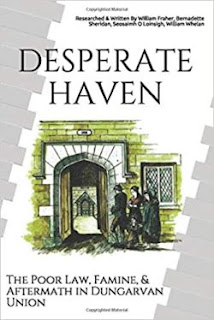The book – the product of more than five years research by Dungarvan Museum Society (now Waterford County Museum) – was originally published in 1996 and has been much sought after since it went out of print.
 |
| Republished in paperback and Kindle formats |
Based on the Minute Books of the Dungarvan Board of Guardians, the Famine Relief Papers, and contemporary newspapers, the book traces the development of the Dungarvan Poor Law Union from its establishment in 1839 to its abolition in 1920.
Inevitably, Dungarvan Workhouse prominently in this story. At the height of the Famine, some 4,000 men, women and children from the area were housed within the walls of the main and auxiliary workhouses of the Union. The authors examine in detail the lives of inmates, with sections on diet, education, work, the workhouse farm, religion, the treatment of women and children. Thousands more were dependent on soup kitchens and "outdoor relief" to prevent themselves starving.
The book also looks at the effect of the famine on the fishing industry and on emigration from the area during and after the Famine.
Whether or not you have ancestors from the area, this book will provide family historians with a good understanding of how and why Poor Law Unions were set up and managed, of the harsh realities of life (and death) in the Workhouse, and the conditions that drove them to flee abroad in such numbers.
The 258-page book, authored by William Fraher, William Whelan, Bernadette Sheridan, and Seosaimh O Loinsigh, is available in both paperback and Kindle format via US & Canada Amazon and IE & UK Amazon.
